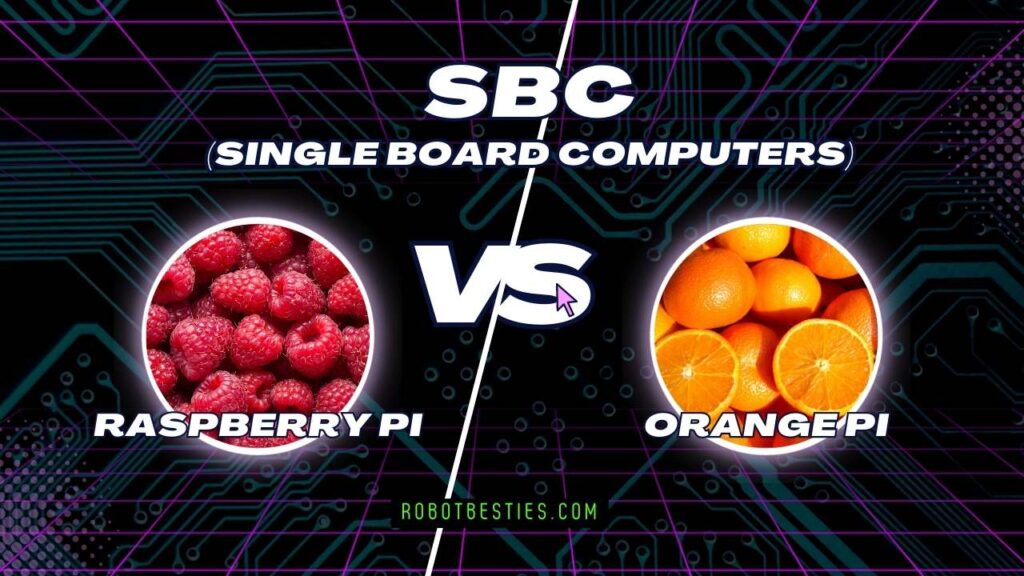Let’s explore the differences between the Orange Pi 5 Plus and Raspberry Pi 4 Model B (with use case examples for each)
When it comes to single-board computers (SBCs), the Orange Pi 5 Plus and Raspberry Pi 4 Model B are two popular choices among tech and DIY enthusiasts. While both offer impressive capabilities, they have distinct differences that make them suitable for various use cases. In this blog post, we will delve into the disparities between these SBCs and explore use case examples for each.
Performance and Processing Power
The Orange Pi 5 Plus is equipped with a powerful Rockchip RK3566 quad-core Cortex-A55 processor, clocked at 1.8GHz, and a Mali-G52 GPU. On the other hand, the Raspberry Pi 4 Model B features a Broadcom BCM2711 quad-core Cortex-A72 processor, clocked at 1.5GHz, and a VideoCore VI GPU. These differences in processing power make each SBC suitable for specific use cases.
Use Case Examples for Orange Pi 5 Plus:
- Media Center: The Orange Pi 5 Plus’s superior GPU performance makes it an excellent choice for media center applications, allowing smooth playback of high-resolution videos and demanding multimedia tasks.
- Edge Computing: With its powerful CPU and GPU, the Orange Pi 5 Plus can handle complex edge computing tasks, such as real-time data processing and AI inference, making it ideal for IoT and AI applications.
- Gaming Console: The Orange Pi 5 Plus’s Mali-G52 GPU ensures smooth gaming experiences, making it a viable option for retro gaming enthusiasts or those looking to build their own gaming console.
Use Case Examples for Raspberry Pi 4 Model B:
- Home Automation: The Raspberry Pi 4 Model B’s processing power, combined with its GPIO pins, makes it a perfect choice for home automation projects, allowing users to control various devices and sensors.
- Desktop Replacement: With its improved CPU and GPU performance, the Raspberry Pi 4 Model B can serve as a viable desktop replacement for basic computing tasks, web browsing, and office applications.
- Robotics and AI: The Raspberry Pi 4 Model B’s processing capabilities, coupled with its GPIO pins and camera module, make it an excellent choice for robotics and AI projects, enabling users to build autonomous robots or implement computer vision applications.
Connectivity and Expansion Options
The Orange Pi 5 Plus and Raspberry Pi 4 Model B offer different connectivity and expansion options, allowing users to tailor their projects accordingly.
Use Case Examples for Orange Pi 5 Plus
- Network Attached Storage (NAS): The Orange Pi 5 Plus’s Gigabit Ethernet and USB 3.0 ports make it suitable for building a high-speed NAS, enabling users to create their own personal cloud storage solution.
- Digital Signage: With its HDMI 2.0a port and support for 4K resolution, the Orange Pi 5 Plus can be utilized for digital signage applications, displaying high-quality content on large screens.
- IoT Gateway: The Orange Pi 5 Plus’s built-in Wi-Fi and Bluetooth capabilities, combined with its processing power, make it an ideal choice for building an IoT gateway, facilitating communication between various IoT devices.
Use Case Examples for Raspberry Pi 4 Model B
- Retro Gaming Console: The Raspberry Pi 4 Model B’s HDMI port and USB ports make it easy to connect to a TV or monitor, making it an excellent choice for building a retro gaming console using popular emulation software.
- Home Server: With its Gigabit Ethernet and USB 3.0 ports, the Raspberry Pi 4 Model B can be transformed into a home server, allowing users to host websites, file sharing, or even a personal cloud server.
- Network Monitoring: The Raspberry Pi 4 Model B’s Ethernet port and GPIO pins make it suitable for network monitoring projects, enabling users to monitor network traffic, analyze data, and implement security measures.
What’s Your Project, and Which Board Will You Choose?
While both the Orange Pi 5 Plus and Raspberry Pi 4 Model B are powerful SBCs, they have distinct differences that cater to various use cases. Understanding these disparities can help users choose the right SBC for their specific project requirements. Whether it’s media center applications, edge computing, home automation, or gaming consoles, both SBCs offer a wide range of possibilities for tech enthusiasts and DIY enthusiasts alike.



